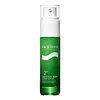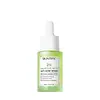What's inside
What's inside
 Key Ingredients
Key Ingredients

 Benefits
Benefits

 Concerns
Concerns

 Ingredients Side-by-side
Ingredients Side-by-side

Water
Skin ConditioningButylene Glycol
HumectantGlycerin
HumectantSalicylic Acid
MaskingAcacia Senegal Gum
MaskingNiacinamide
SmoothingCaprylic/Capric Glycerides Polyglyceryl-10 Esters
EmollientHydroxyacetophenone
Antioxidant1,2-Hexanediol
Skin ConditioningPentylene Glycol
Skin ConditioningHydrolyzed Sclerotium Gum
HumectantPrunus Amygdalus Dulcis Oil
Skin ConditioningO-Cymen-5-Ol
AntimicrobialMadecassoside
AntioxidantHydroxyphenyl Propamidobenzoic Acid
Skin ConditioningHydrogenated Lecithin
EmulsifyingQuaternium-73
Citric Acid
BufferingWater, Butylene Glycol, Glycerin, Salicylic Acid, Acacia Senegal Gum, Niacinamide, Caprylic/Capric Glycerides Polyglyceryl-10 Esters, Hydroxyacetophenone, 1,2-Hexanediol, Pentylene Glycol, Hydrolyzed Sclerotium Gum, Prunus Amygdalus Dulcis Oil, O-Cymen-5-Ol, Madecassoside, Hydroxyphenyl Propamidobenzoic Acid, Hydrogenated Lecithin, Quaternium-73, Citric Acid
Water
Skin ConditioningButylene Glycol
HumectantNiacinamide
SmoothingGlycerin
HumectantPPG-10 Methyl Glucose Ether
Skin ConditioningPentylene Glycol
Skin Conditioning1,2-Hexanediol
Skin ConditioningSalicylic Acid
MaskingAcacia Senegal Gum
MaskingAcrylates/C10-30 Alkyl Acrylate Crosspolymer
Emulsion StabilisingTriethanolamine
BufferingMethylpropanediol
SolventEctoin
Skin ConditioningDipotassium Glycyrrhizate
HumectantPlatonin
Skin ConditioningCeramide AP
Skin ConditioningCeramide NP
Skin ConditioningCeramide Ns
Skin ConditioningCentella Asiatica Extract
CleansingDisodium EDTA
Tartaric Acid
BufferingMalic Acid
BufferingPeumus Boldus Leaf Extract
MaskingPPG-26-Buteth-26
Skin ConditioningAllantoin
Skin ConditioningO-Cymen-5-Ol
AntimicrobialEthylhexylglycerin
Skin ConditioningGlyceryl Caprylate
EmollientPEG-40 Hydrogenated Castor Oil
EmulsifyingMenthol
MaskingCaprylyl Glycol
EmollientXanthan Gum
EmulsifyingHydrolyzed Royal Jelly Protein
Skin ConditioningOligopeptide-1
Skin ConditioningSodium Hyaluronate
HumectantGlycolipids
Skin ConditioningGlycosphingolipids
EmollientPropanediol
SolventSodium Lactate
BufferingGlycolic Acid
BufferingSucrose
HumectantUrea
BufferingSodium Citrate
BufferingPhenoxyethanol
PreservativeWater, Butylene Glycol, Niacinamide, Glycerin, PPG-10 Methyl Glucose Ether, Pentylene Glycol, 1,2-Hexanediol, Salicylic Acid, Acacia Senegal Gum, Acrylates/C10-30 Alkyl Acrylate Crosspolymer, Triethanolamine, Methylpropanediol, Ectoin, Dipotassium Glycyrrhizate, Platonin, Ceramide AP, Ceramide NP, Ceramide Ns, Centella Asiatica Extract, Disodium EDTA, Tartaric Acid, Malic Acid, Peumus Boldus Leaf Extract, PPG-26-Buteth-26, Allantoin, O-Cymen-5-Ol, Ethylhexylglycerin, Glyceryl Caprylate, PEG-40 Hydrogenated Castor Oil, Menthol, Caprylyl Glycol, Xanthan Gum, Hydrolyzed Royal Jelly Protein, Oligopeptide-1, Sodium Hyaluronate, Glycolipids, Glycosphingolipids, Propanediol, Sodium Lactate, Glycolic Acid, Sucrose, Urea, Sodium Citrate, Phenoxyethanol
 Reviews
Reviews

Ingredients Explained
These ingredients are found in both products.
Ingredients higher up in an ingredient list are typically present in a larger amount.
1,2-Hexanediol is a synthetic liquid and another multi-functional powerhouse.
It is a:
- Humectant, drawing moisture into the skin
- Emollient, helping to soften skin
- Solvent, dispersing and stabilizing formulas
- Preservative booster, enhancing the antimicrobial activity of other preservatives
Acacia Senegal Gum has skin soothing, thickening, and formulation stabilizing properties. It comes from the Acacia tree that is native to sub-Saharan Africa.
Butylene Glycol (or BG) is used within cosmetic products for a few different reasons:
Overall, Butylene Glycol is a safe and well-rounded ingredient that works well with other ingredients.
Though this ingredient works well with most skin types, some people with sensitive skin may experience a reaction such as allergic rashes, closed comedones, or itchiness.
Learn more about Butylene GlycolGlycerin is already naturally found in your skin. It helps moisturize and protect your skin.
A study from 2016 found glycerin to be more effective as a humectant than AHAs and hyaluronic acid.
As a humectant, it helps the skin stay hydrated by pulling moisture to your skin. The low molecular weight of glycerin allows it to pull moisture into the deeper layers of your skin.
Hydrated skin improves your skin barrier; Your skin barrier helps protect against irritants and bacteria.
Glycerin has also been found to have antimicrobial and antiviral properties. Due to these properties, glycerin is often used in wound and burn treatments.
In cosmetics, glycerin is usually derived from plants such as soybean or palm. However, it can also be sourced from animals, such as tallow or animal fat.
This ingredient is organic, colorless, odorless, and non-toxic.
Glycerin is the name for this ingredient in American English. British English uses Glycerol/Glycerine.
Learn more about GlycerinNiacinamide is a multitasking form of vitamin B3 that strengthens the skin barrier, reduces pores and dark spots, regulates oil, and improves signs of aging.
And the best part? It's gentle and well-tolerated by most skin types, including sensitive and reactive skin.
You might have heard of "niacin flush", or the reddening of skin that causes itchiness. Niacinamide has not been found to cause this.
In very rare cases, some individuals may not be able to tolerate niacinamide at all or experience an allergic reaction to it.
If you are experiencing flaking, irritation, and dryness with this ingredient, be sure to double check all your products as this ingredient can be found in all categories of skincare.
When incorporating niacinamide into your routine, look out for concentration amounts. Typically, 5% niacinamide provides benefits such as fading dark spots. However, if you have sensitive skin, it is better to begin with a smaller concentration.
When you apply niacinamide to your skin, your body converts it into nicotinamide adenine dinucleotide (NAD). NAD is an essential coenzyme that is already found in your cells as "fuel" and powers countless biological processes.
In your skin, NAD helps repair cell damage, produce new healthy cells, support collagen production, strengthen the skin barrier, and fight environmental stressors (like UV and pollution).
Our natural NAD levels start to decline with age, leading to slower skin repair, visible aging, and a weaker skin barrier. By providing your skin niacinamide, you're recharging your skin's NAD levels. This leads to stronger, healthier, and younger looking skin.
Another name for vitamin B3 is nicotinamide. This vitamin is water-soluble and our bodies don't store it. We obtain Vitamin B3 from either food or skincare. Meat, fish, wheat, yeast, and leafy greens contain vitamin B3.
The type of niacinamide used in skincare is synthetically created.
Learn more about NiacinamideThis ingredient is more commonly known as IPMP or Isopropyl Methylphenol. It is a preservative and has antimicrobial properties.
According to the EPA, this ingredient is allowed for use in cleansers, creams, powders, bath products, toothpaste, perfume, and more.
Pentylene glycol is typically used within a product to thicken it. It also adds a smooth, soft, and moisturizing feel to the product. It is naturally found in plants such as sugar beets.
The hydrophilic trait of Pentylene Glycol makes it a humectant. As a humectant, Pentylene Glycol helps draw moisture from the air to your skin. This can help keep your skin hydrated.
This property also makes Pentylene Glycol a great texture enhancer. It can also help thicken or stabilize a product.
Pentylene Glycol also acts as a mild preservative and helps to keep a product microbe-free.
Some people may experience mild eye and skin irritation from Pentylene Glycol. We always recommend speaking with a professional about using this ingredient in your routine.
Pentylene Glycol has a low molecular weight and is part of the 1,2-glycol family.
Learn more about Pentylene GlycolSalicylic Acid (also known as beta hydroxy acid or BHA) is a well-known ingredient for treating skin that struggles with acne and clogged pores. It exfoliates both the skin's surface and deep within the pores to help clear out buildup, control oil, and reduce inflammation.
Unlike AHAs (alpha hydroxy acids), salicylic acid is oil-soluble. This allows it to penetrate into pores which makes it especially effective for treating blackheads and preventing future breakouts.
Salicylic acid is also known for its soothing properties. It has a similar structure to aspirin and can calm inflamed or irritated skin, making it a good option for acne-prone skin that is also sensitive.
Concentrations of 0.5-2% are recognized by the U.S. FDA as an over-the-counter topical acne product.
It can cause irritation and/or dryness if one's skin already has a compromised moisture barrier, so it's best to focus on repairing that before introducing this ingredient into your routine.
While salicylic acid does not increase sun sensitivity, it’s still important to wear sunscreen daily to protect your skin.
If you are looking for the ingredient called BHA or Butylated Hydroxyanisole, click here.
Learn more about Salicylic AcidWater. It's the most common cosmetic ingredient of all. You'll usually see it at the top of ingredient lists, meaning that it makes up the largest part of the product.
So why is it so popular? Water most often acts as a solvent - this means that it helps dissolve other ingredients into the formulation.
You'll also recognize water as that liquid we all need to stay alive. If you see this, drink a glass of water. Stay hydrated!
Learn more about Water